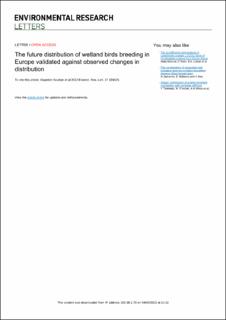The future distribution of wetland birds breeding in Europe validated against observed changes in distribution
Soultan, Alaaeldin; Pavòn-Jordàn, Diego; Bradter, Ute; Sandercock, Brett; Hochachka, Wesley M.; Johnston, Alison; Brommer, Jon; Gaget, Elie; Keller, Verena; Knaus, Peter; Aghababyan, Karen; Maxhuni, Qenan; Vintchevski, Alexandre; Nagy, Károly; Raudonikis, Liutauras; Balmer, Dawn E.; Noble, David; Leitão, Domingos; Øien, Ingar Jostein; Shimmings, Paul; Sultanov, Elchin; Caffrey, Brian; Boyla, Kerem; Radišić, Dimitrije; Lindström, Åke; Velevski, Metodija; Pladevall, Clara; Brotons, Lluis; Karel, Šťastný; Rajković, Draženko Z.; Chodkiewicz, Tomasz; Wilk, Tomasz; Tibor, Szép; van Turnhout, Chris; Foppen, Ruud; Burfield, Ian; Vikstrøm, Thomas; Mazal, Vlatka Dumbović; Eaton, Mark; Vorisek, Petr; Lehikoinen, Aleksi; Herrando, Sergi; Kuzmenko, Tatiana; Bauer, Hans-Günther; Kalyakin, Mikhail; Voltzit, Olga; Sjeničić, Jovica; Pärt, Tomas
Peer reviewed, Journal article
Published version

Åpne
Permanent lenke
https://hdl.handle.net/11250/3010246Utgivelsesdato
2022Metadata
Vis full innførselSamlinger
- Publikasjoner fra CRIStin - NINA [2364]
- Scientific publications [1392]
Originalversjon
10.1088/1748-9326/ac4ebeSammendrag
Wetland bird species have been declining in population size worldwide as climate warming and land-use change affect their suitable habitats. We used species distribution models (SDMs) to predict changes in range dynamics for 64 non-passerine wetland birds breeding in Europe, including range size, position of centroid, and margins. We fitted the SDMs with data collected for the first European Breeding Bird Atlas and climate and land-use data to predict distributional changes over a century (the 1970s–2070s). The predicted annual changes were then compared to observed annual changes in range size and range centroid over a time period of 30 years using data from the second European Breeding Bird Atlas. Our models successfully predicted ca. 75% of the 64 bird species to contract their breeding range in the future, while the remaining species (mostly southerly breeding species) were predicted to expand their breeding ranges northward. The northern margins of southerly species and southern margins of northerly species, both, predicted to shift northward. Predicted changes in range size and shifts in range centroids were broadly positively associated with the observed changes, although some species deviated markedly from the predictions. The predicted average shift in core distributions was ca. 5 km yr−1 towards the north (5% northeast, 45% north, and 40% northwest), compared to a slower observed average shift of ca. 3.9 km yr−1. Predicted changes in range centroids were generally larger than observed changes, which suggests that bird distribution changes may lag behind environmental changes leading to 'climate debt'. We suggest that predictions of SDMs should be viewed as qualitative rather than quantitative outcomes, indicating that care should be taken concerning single species. Still, our results highlight the urgent need for management actions such as wetland creation and restoration to improve wetland birds' resilience to the expected environmental changes in the future.
